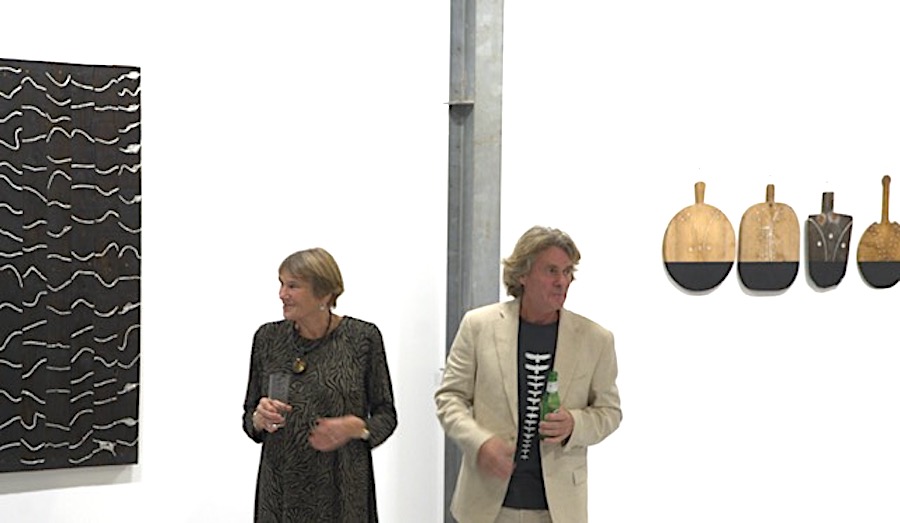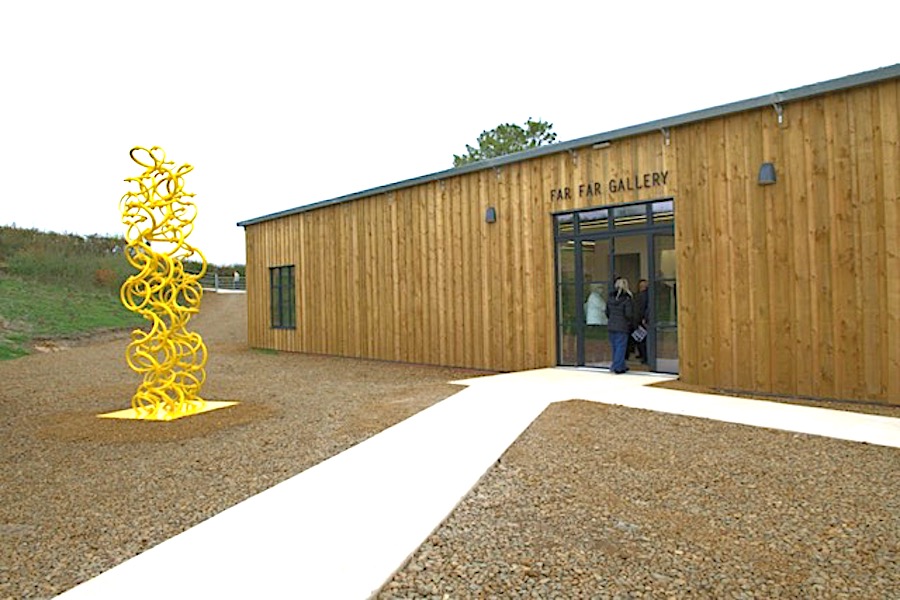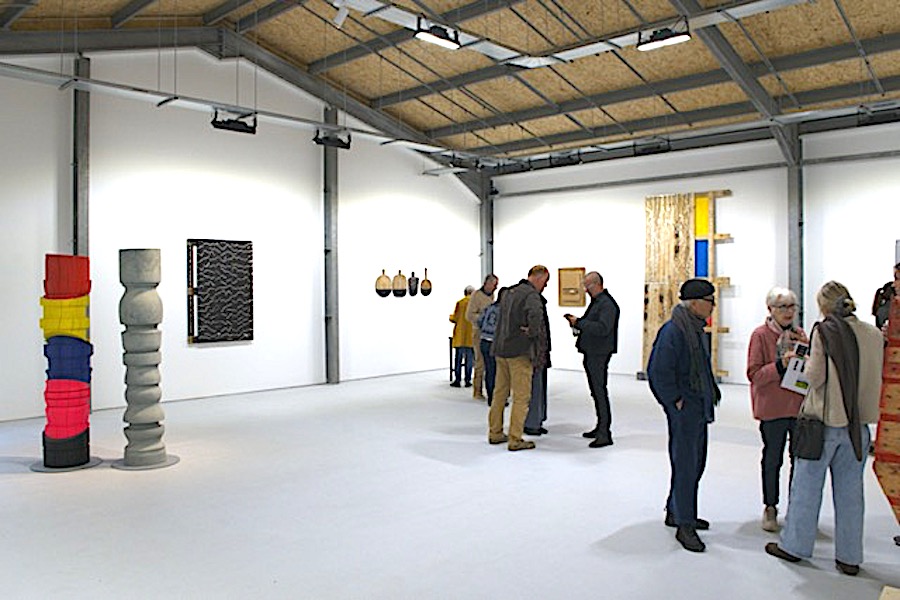As the UK art world reels from the closures of major commercial galleries like Pace, Almine Rech, and Marlborough, an imaginative grassroots revival is quietly taking hold: family-run and artist-led spaces are transforming converted living rooms, barns, cottages, and studios into lively cultural lifelines. These ventures provide not just places for exhibition, but nurturing environments for contemporary artists and local communities, demonstrating heartwarming resiliency in the face of broader market uncertainty. This story begins with the opening of a box, made from upcycled cardboard expertly reconfigured to house a work of art that sits snugly inside. This piece is one of a pair—sculptures fashioned from wood, tin, and paint, their forms interlocking. Three words, ‘flow, constant, flow’, trail down the furthest panel on the right, which also bisects a plank behind to form the shape of a cross. To the left, a yellow rectangle hovers above a blue, then a succession of wooden panels shimmering with rivulets of tin, echoing the movement of a riverbed. The second work is unboxed, also bearing the three words ‘constant, flow, constant’ inscribed on the final plank. Here, a wooden plank bisects rectangles of red over black, and to the left, more glimmering rivulets. At first glance, the blocks of colour suggest flags, but it is the glint of metal that holds my attention.
The works are then stacked atop one another, propped against the wall and raised off the floor on two breeze blocks, which Theresa Bell has found outside, amongst the leftovers of the new build. Simon Allison, the artist and founder of the Far Far Gallery, steps into the space and beams, “Oh wow, they look fantastic!”. There is a soft, rhythmic rise at the end of his sentence and the unmistakable supplanting of vowel sounds, the “i” in fantastic changed to a “u”. Ben Parsons, guest curator of the gallery’s inaugural show ‘Works 70’, tunefully agrees. Together they walk over to the far corner of the luminous space and perch on the windowsill, deep in conversation. The countdown to opening is three weeks and ticking.
I remain standing before the monumental work, eyes travelling up and down the glinting squiggles of tin. Allison returns, anticipating my question, and explains, “the words ‘constant flow’ stem from a passage adapted from Shinran’s songs to Amida Honen, a Japanese Buddhist text from the 1100s, that is also the title of a seminal work of art by one of Aotearoa’s greatest painters Colin McCahon ‘As there is a constant flow of light we are born into the pure land,’ (1965).” Also using paint and plywood, one of McCahon’s paintings in this series shows a yellow bank of buttercup fields under a radiant kingfisher blue sky; another shows a sky of extraordinary radiance over a dark plain. Later (when I went to research the artist) I found a postscript by John Coley who acquired the work at auction, “Could such a painting be made in any other place by any other artist?” He should visit Cropredy.

Whilst artists are often portrayed as wrestling alone to bring ideas to life (indeed, the process can be lonely), their work is rarely made in true isolation. It emerges from a dynamic, interconnected world, and joins the ‘constant, evolving flow’ of history. This multidimensional art space reveals its founders’ enduring love for art and their deep connection to this place. “One of my conundrums as an artist from Aotearoa living here,” Allison reflects, “is that a lot of my language is not from here. Yet after years of living and working in this place, it’s oddly resonant.” His words are a strange mix of clarity that comes from self-awareness and nostalgia, as if speaking in hindsight. As I scan other selected works propped up against the wall, I see the letters ‘H, A, T, H’ carved into a black square. They are both sombre and playful, as if they once belonged on a tombstone but have been set free.
“It’s so exciting to see text appearing in Allison’s practice,” says Parsons, his tone also rising at the end of the sentence. “It takes us in a new direction from the more abstract celebrations of materiality, whilst referencing text’s role in contemporary Aotearoa New Zealand art.” Allison continues, “That element relates to the braided rivers of the South Island, though there’s irony in calling it ‘constant flow’—given their ecological decline. And that’s a pressing issue here too.” He lets this truth fill the quiet.
From our conversation, these works reverberate with layered meanings: dual flags might suggest dual nationality, but also connect to a theme uniting many of the works in the show – that of globalisation and flags of convenience – the ambiguous provenance and creation of the things we use daily. You can see that Allison addresses this in his practice by incorporating the pallet – something that is otherwise discarded – as both a material and a motif. “We’ll probably have a stack of actual pallets just here, some actually from wood, but a few cast in bronze.”
His language, both spoken and embedded in his art, is focused and belies a deep commitment to both his practice and the place that has given him the freedom to make art all his life. These words have been galvanised into action, in the building of a gallery space – large enough to host two shows simultaneously and a workspace for an artist in residence. Ambitious in scale and generous in concept, the Far Far Gallery will continue and expand the program he successfully ran with his wife, the artist Jane Hamilton, via Lockbund Gallery associated with their cottage foundry. Their support has uplifted others, including Olivia Bax, Lara Faroqui and Bridget McCrum, and their vision is to foster a community of contemporary artists and enable those who might not otherwise be able to create three-dimensional works. This is a family endeavour, too— their daughters work at the foundry, and his son, an architect, transformed the barn. Not unlike other artist-led spaces flourishing in post-Brexit, post-pandemic Britain—near cultural centres like Compton Verney and Banbury Museum—Far Far Gallery feels both timely and essential.

Walking through the well-proportioned rooms, exposed steel beams, newly painted white walls softened by exposed wooden ceiling, I get the sense that we are walking through one of his sculptures. Generous glass double doors open out onto the field, which rises towards the distant horizon; a meandering footpath appears and disappears in the tall grass between a series of outdoor sculptures. I catch the ephemeral flicker of a few late summer butterflies, and feel myself inhale deeply into the whole, reassuringly bucolic scene. You can tell that someone really cares about this place, and it feels perfect to be here.
But let us return to that conversation between artist and curator in the far corner of a cavernous space that was once a grain barn. “We just put that one there for now, but we will move it into the atelier, which will be populated with all of the fibreglass and wood pieces for the opening – like a little forest,” says Parsons. “We want to activate the entire space, to let visitors see everything, but also create environments that suit specific series. Upstairs in the storage space, we are going to place some time-based media works, where the light is nice and subdued.” His energy is contagious; there’s eager anticipation for the Far Far Gallery’s launch.
Against a backdrop of economic uncertainty, radical upheaval in the art market, and a dearth of commercial gallery closures, this is a story about creative resilience, and the perseverance of artists – already emboldened by surviving a pandemic, Brexit and numerous other challenges facing the art world today – who respond creatively to adversity and shape our future in ways we had not imagined.
As Peter James Smith says in his catalogue essay, “Material. Fire. Passion. This is the zeitgeist… Use your materials—your paint, your canvas, your timber, lead and bronze—use it with passion. Use it in new ways. Take it beyond what has been known before… a gallery has literally risen from the chaff of the Van Gogh field. The Far Far Gallery is a placeholder of material passion.”
Exhibition Open Thereafter: 12 October – 7 December 2025 by appointment on request

